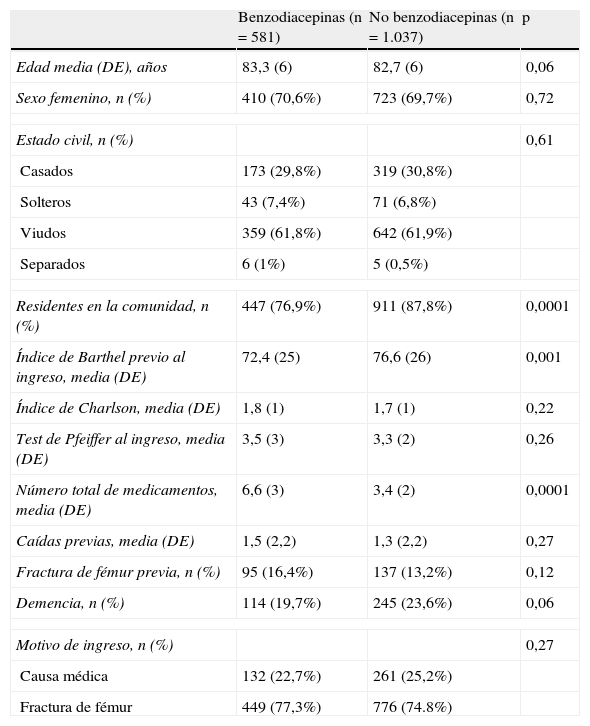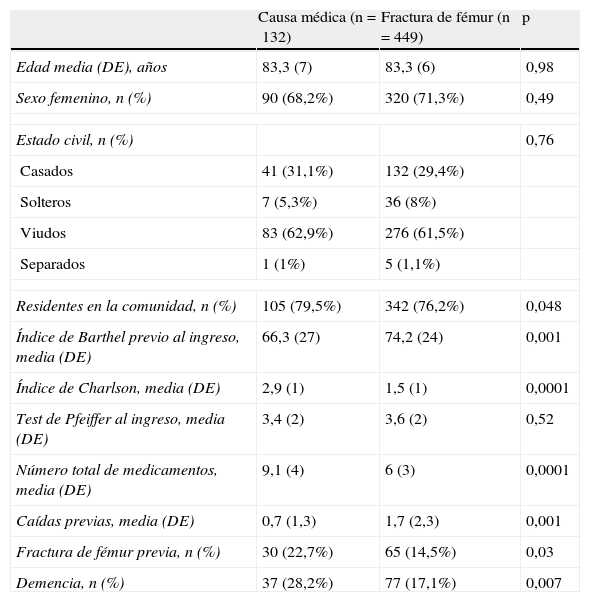El consumo crónico de benzodiacepinas es frecuente en los pacientes ancianos. El objetivo del estudio es evaluar posibles diferencias entre los pacientes que toman benzodiacepinas y los que no. Además, se analiza si hay diferencias entre los tratados con benzodiacepinas según si el motivo del ingreso hospitalario era médico o quirúrgico.
Pacientes y metodoSe realizó un estudio prospectivo y multicéntrico de 393 pacientes ingresados por causa médica en 6 unidades geriátricas de agudos y se compararon con datos previos de 1.225 ingresados por fractura de fémur. Se recogieron datos sociodemográficos, la capacidad funcional mediante el índice de Barthel (IB), la comorbilidad (índice de Charlson), y de detección de deterioro cognitivo (test de Pfeiffer).
ResultadosSe incluyeron 1.618 pacientes, con una media (DE) de edad de 82,9 (6,5) años. Tomaban de forma crónica benzodiacepinas un total de 581 (35,9%) pacientes, 132 (33,6%) de los ingresos por causa médica y 449 (36,6%) de los ingresos por fractura de fémur (p=0,27). En el análisis multivariante se asoció a la toma de benzodiacepinas una mayor edad, el estar institucionalizado y un mayor consumo total de fármacos. Entre los pacientes que tomaban benzodiacepinas de forma crónica destacaba que los que ingresaban por causa médica vivían más en la comunidad, caían menos, tenían un peor IB, y mayor comorbilidad y polifarmacia.
ConclusionesMás de una tercera parte de los pacientes mayores ingresados por causa médica o traumatológica tomaban benzodiacepinas de forma crónica. Existen diferencias en los perfiles de los pacientes según tomaran o no benzodiacepinas, así como entre los que tomaban benzodiacepinas según cuál fuera el motivo de ingreso hospitalario.
Chronic consumption of benzodiazepines is common in elderly patients. The aim of the study was to analyse the possible differences between patients taking benzodiazepines and those without them. We also determined, among patients on benzodiazepines, if any differences were related to medical or surgical admissions.
Patients and methodsWe performed a prospective and multicentre study of 393 patients admitted consecutively for medical reasons to 6 geriatrics acute units; these patients were compared to 1,225 patients hospitalized for a hip fracture. We collected sociodemographic data, functional capacity by the Barthel's index (BI), comorbidity by the Charlson's index and cognitive impairment by the Pfeiffer test.
ResultsWe evaluated 1,618 patients, with a median age of 82.9 (6.5) years. Among patients admitted for medical causes, 581 (35.9%) were taking benzodiazepines chronically as did 449 (36.6%) patients in the hip fracture group (p=0.27). In the multivariate analysis, factors associated with the use of benzodiazepines included older age, institutionalization and a higher number of drug consumption. Differences according to the admission reason showed that patients admitted for medical causes lived more frequently in the community and had less falls, worse BI as well as a higher number of comorbidities and polypharmacy.
ConclusionsMore than one third of elderly patients hospitalized for medical or traumatology causes were taking benzodiazepines chronically. Different patients’ profiles can be observed according to whether they are or not taking benzodiazepines and to the admission's cause in the subgroup of patients on benzodiazepines.
Artículo
Comprando el artículo el PDF del mismo podrá ser descargado
Precio 19,34 €
Comprar ahora








